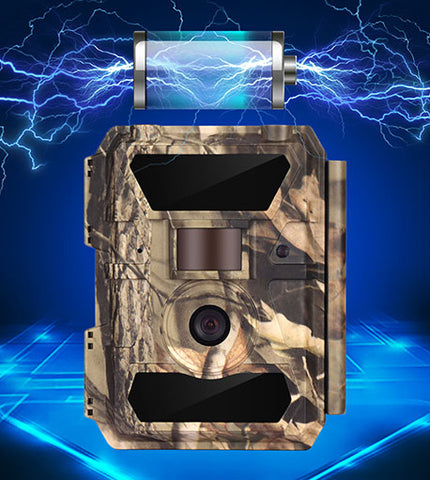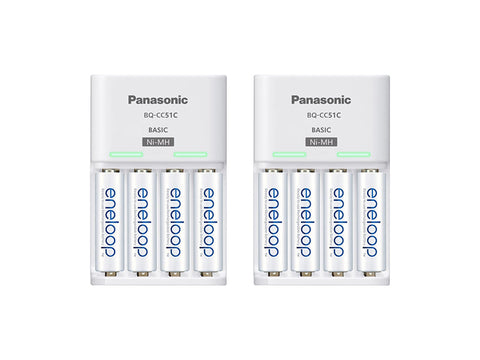
Yes, trail cameras provide the most effective, convenient means of remotely monitoring wildlife. But, like every awesome piece of technology, they require power. And if that power runs out too quickly then your super-useful piece of kit all too soon becomes just a fancy outdoor decoration.
No wonder then that the number one question trail camera users most commonly ask is…
“How can I get the best life out of my trail camera batteries?”
To answer this question we will go through…
1. The 5 types of battery be used in trail cameras
And after doing so decide which type you should use. Then we can look at…
2. The 3 top tips to extend your trail cam’s battery life
If you have any questions after reading, feel free to drop us a line.
1. The 5 Types of Batteries Used in Trail Cameras
First let’s split up batteries into the two main types you will undoubtedly be familiar with: non-rechargeable and rechargeable.
Non-rechargeable
Think of batteries and what comes to mind? Cheap, single-use, conveniently able to be thrown out once they’re done? Probably, and this is their benefit but also their massive drawback: OK they’re cheap, but you have to constantly keep buying them so the cost builds and builds. Plus, every time you throw them out, you’re really not doing the environment much of a favor.
Just consider that in the state of California all batteries are considered hazardous waste when discarded. If you’re using trail cameras to capture the wonders of the natural world, this is bound to be a big concern.
But let’s take a look at the 3 types of rechargeable battery currently on the market to see why they’re still used by many trail camera owners…
Zinc
Almost as important knowing which type to choose, is knowing which type to steer a wide mile from. Coming in two varieties, original zinc carbon and updated zinc chloride (known commercially as heavy-duty or super-heavy-duty batteries), these were the first batteries for mass use and state-of-the-art at the time.
But they now serve as a very feeble power source: OK for low power devices such as TV remotes but definitely not up to scratch for high-tech devices such as trail cameras.
WingHome score: 0/5
Alkaline

Accounting for 80% of batteries manufactured in the US, these are clearly the go-to for most people looking to power their devices with AA or AAA batteries. They provide up to 5 times the capacity of zinc batteries, clearly a step-up.
But for trail camera purposes they still can’t provide the kind of battery life you can safely rely on, lasting only around 2 months recording 100 photos a day. Couple that with the fact that the voltage they can produce declines progressively, causing ever worse pictures and videos over time, then they’re far from ideal.
WingHome score 3/5
Lithium

More accurately called lithium metal batteries to differentiate them from lithium-ion batteries, the rechargeable type in our phones, these are a popular choice with trail cam users. This comes from their large capacity, lasting up to 4 times longer than alkaline batteries, the fact that they provide consistent voltage throughout their life, and also their crazy low operating temperature of down to -40ºF.
Besides the difficulty of getting hold of them compared to their alkaline counterparts, and their huge price tag of around $1.50 per battery, lithium batteries can come with a nasty surprise. Providing extremely high currents and rapid discharge when short-circuited, they can overheat, rupture, and even explode!
WingHome score: 3.5/5
Non-rechargeable Recap
For very infrequent trail camera users, who just want the cheapest batteries and are not going to be causing too much damage by throwing tons of them away, then non-rechargeable batteries can be a good choice. However, there is a better option…
Rechargeable
There’s no doubt about it, we should all be doing our best to look after the environment, and a big part of that is switching to rechargeable batteries across all our devices.
It’s true that the initial outlay is somewhat greater but just even after just a little calculating we can see that the long-term cost is way lower. A single non-rechargeable alkaline battery will cost you around 25 cents, compared to $2.50 for a rechargeable battery. But re-use that same battery 1,000 times and it ends up costing a measly 0.25 cents, a truly massive saving!
That being said, let’s look at what types of rechargeable batteries we have to choose from….
Lithium polymer (LiPo)
What if you could get the benefits of lithium metal batteries and be able to reuse them too? That’s the promise that lithium polymer batteries offer.
Unfortunately, at the moment of writing, the current line of lithium polymer batteries is still in the early stages of development, with too many glitches for us to recommend them right now.
WingHome score: watch this space
Nickel Metal (NiMH)

Now we come to the real deal! These are the gold standard of rechargeable AA batteries on the market right now. Double the capacity of alkaline batteries, with an operating temperature of down to -4ºF and environmentally friendly when eventually you do have to throw them out after 1,000 recharges, these seem the perfect solution for the trail camera user.
Unfortunately, the conventional thinking is that they’re not suitable for use with trail cameras. Why so? It’s because they operate at a 20% lower voltage than alkaline or lithium batteries, and so are not compatible with all trail cameras on the market.
The good news, however, is that recent developments in trail camera technology mean that more and more trail cameras are compatible with this type of battery, including, we are proud to say, all WingHome trail cameras.
WingHome score: 5/5
Battery Type Recap
So, there you have it! If you have older generation trail cams that need a higher voltage to function effectively, then the best option, though with the caveats mentioned above, is lithium batteries.
However, for the sake of the environment and your own pocket we really recommend finding a trail camera that will work with rechargeable NiMH batteries. Visit our Amazon store now to take a look.
Bonus! - How Long Will Rechargeable Batteries Last in My Trail Camera?
Once you have decided on a trail camera that’s compatible with rechargeable batteries, you’re going to want to know how long they’re going to last, so you can predict when you need to recharge them.
See below for a table with all the information you all you need about NiMH rechargeable battery life in the WingHome 290C.
|
Photos |
Video |
||||||
|
Resolution |
Photos Per Day (No.) |
Use Time (Days) |
Use Time (Months) |
Resolution |
10-sec Videos Per Day (No.) |
Use Time (Days) |
Use Time (Months) |
|
IR LEDs On |
|||||||
|
12MP |
100 |
128 |
4.2 |
640 x 480 |
10 |
118 |
3.9 |
|
14MP |
100 |
122 |
4 |
1280 x 720 |
10 |
114 |
3.7 |
|
16MP |
100 |
114 |
3.7 |
1920 x 1080 |
10 |
108 |
3.5 |
|
IR LEDs Off |
|||||||
|
12MP |
100 |
144 |
4.7 |
640 x 480 |
20 |
326 |
10.7 |
|
14MP |
100 |
134 |
4.4 |
1280 x 720 |
20 |
302 |
9.9 |
|
16MP |
100 |
122 |
4 |
1920 x 1080 |
20 |
280 |
9.2 |
Looking at this table we can get the first of….
- The 3 Top Tips to Extend Your Trail Cam’s Battery Life

-
Tip #1
As can be seen from the table, the trail camera’s IR LEDs, which are used for night vision, don’t have too much of an impact on battery life when used for photos but have a significant impact on videos. So…
#1 - Reduce night vision video as far as possible.
Tip #2
We all know that as temperature increases then so does energy, and the same is true vice-versa. This applies to batteries as much as anything else. So…
#2 - Avoid operating your camera at very low temperatures.
Tip #3
The third tip is clear from an analogy with smartphones. What uses the most battery on your smartphone? Take a look and you will see that it is usually the screen.
The same is true for trail cameras. So…
#3 - Open up the trial camera to view the photos and images as infrequently as possible.
But hey, if you’re using rechargeable batteries all you need to do is stick them in the charger again and you’re good to go!
Conclusion
I hope you enjoyed our exploration into the world of trail camera batteries. Like everything in technology, trail camera batteries and other types of power source they use are constantly developing, so let us keep you posted for all the exciting things to come by subscribing to our newsletter below.
Best wishes and happy trails from the WingHome team!WingHome Trail Camera Buy NowLearn More
Empty content. Please select category to preview
Subscribe to nail your wild games
Receive valuable hunting strategies and tips on bowhunting, food plot, trail cam scouting and rut-season dos and don'ts.

0 comments. Write a comment